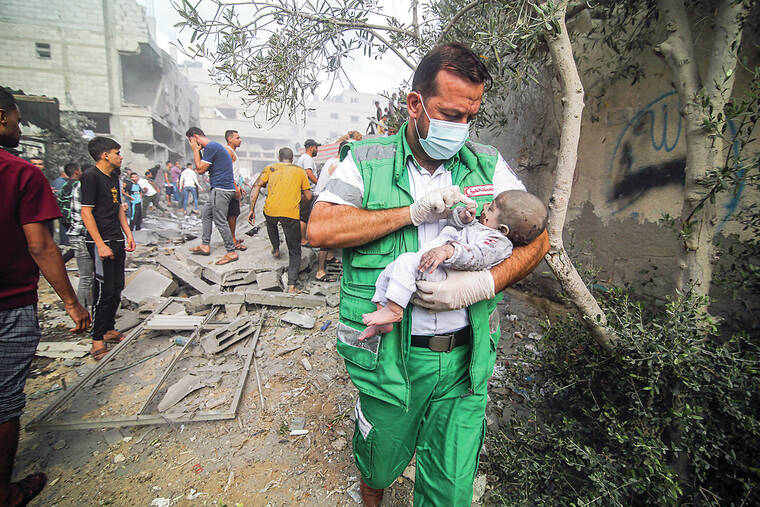Second aid convoy reaches Gaza as Israel attacks targets in Syria and occupied West Bank
RAFAH, Gaza Strip — The second aid convoy destined for desperate Palestinian civilians reached Gaza on Sunday, as Israel widened its attacks to include targets in Syria and the occupied West Bank and the Israeli prime minister warned Lebanon’s Hezbollah militant group that if it launches its own war, “we will cripple it with a force it cannot even imagine.”
For days, Israel has been on the verge of launching a ground offensive in Gaza following Hamas’ brutal Oct. 7 rampage through a series of Israeli communities. Tanks and troops have been massed at the Gaza border, waiting for the command to cross.
ADVERTISING
Israel’s military spokesman, Rear Adm. Daniel Hagari, said the country had increased airstrikes across Gaza to hit targets that would reduce the risk to troops in the next stage of the war.
Fears of a widening war grew as Israeli warplanes struck targets across Gaza, two airports in Syria and a mosque in the occupied West Bank allegedly used by militants.
Israel has traded fire with Hezbollah militants since the war began, and tensions are soaring in the West Bank, where Israeli forces have battled militants in refugee camps and carried out two airstrikes in recent days.
Prime Minister Benjamin Netanyahu told troops in northern Israel that if Hezbollah launches a war, “it will make the mistake of its life. We will cripple it with a force it cannot even imagine, and the consequences for it and the Lebanese state will be devastating.”
Hamas said it fought with Israeli forces near Khan Younis in southern Gaza and destroyed a tank and two bulldozers.
Late Sunday, Hagari announced that a soldier was killed and three others wounded by an anti-tank missile during a raid inside Gaza as part of efforts to rescue more than 200 hostages abducted in the Oct. 7 attack.
On Saturday, 20 trucks entered Gaza in the first aid shipment into the territory since Israel imposed a complete siege two weeks ago.
Israeli authorities said late Sunday they had allowed a second batch of aid into Gaza at the request of the United States. COGAT, the Israeli defense body responsible for Palestinian civilian affairs, said the aid included water, food and medical supplies and that everything was inspected by Israel before it was brought into Gaza.
Israel has not allowed any fuel to enter Gaza.
In a sign of how precarious any movement of aid remains, the Egyptian military said Israeli shelling hit a watchtower on Egypt’s side of the border, causing light injuries. The Israeli military apologized, saying a tank had accidentally fired and hit an Egyptian post, and the incident was being investigated.
Relief workers said far more aid was needed to address the spiraling humanitarian crisis in Gaza, where half the territory’s 2.3 million people have fled their homes. The U.N. humanitarian agency said Saturday’s convoy carried about 4% of an average day’s imports before the war and “a fraction of what is needed after 13 days of complete siege.”
The Israeli military said the humanitarian situation was “under control,” even as the U.N. called for 100 trucks a day to enter.
In a Sunday phone call, Netanyahu and U.S. President Joe Biden “affirmed that there will now be continued flow of this critical assistance into Gaza,” the White House said in a statement.
Israel repeated its calls for people to leave northern Gaza, including by dropping leaflets from the air. It estimated 700,000 have already fled. But hundreds of thousands remain.
That would raise the risk of mass civilian casualties in any ground offensive.
Israeli military officials say Hamas’ infrastructure and underground tunnels are concentrated in Gaza City, in the north, and that the next stage of the offensive will include unprecedented force there. Israel says it wants to crush Hamas.
Officials have also spoken of carving out a buffer zone to keep Palestinians from approaching the border, though they have given no details.
Hospitals packed with patients and displaced people are running low on medical supplies and fuel for generators, forcing doctors to perform surgeries using sewing needles, resorting to vinegar as disinfectant and operating without anesthesia.


